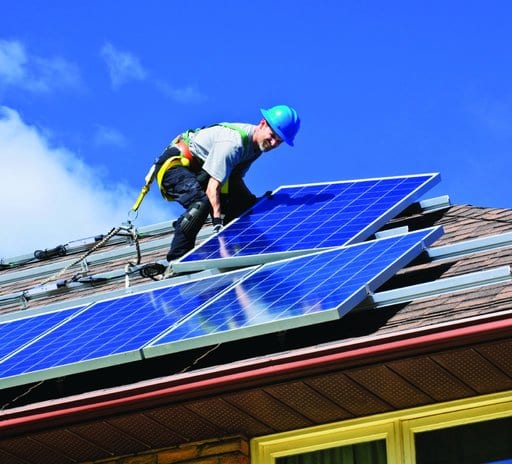The Murdoch media has launched another major attack against rooftop solar, with a front page lead in The Australian newspaper using hopelessly misleading numbers to inflate the cost of the federal government rebate.
The article says the cost of the federal small scale renewable energy scheme (SRES) is “added to all electricity bills” and is likely to increase from $134 a year to $185 a year for each and every household. (And the article was replicated across the Murdoch empire and other media).
Just to be clear, the Australian Energy Market Commission, no great fan of the SRES scheme, estimates the cost of the SRES to be $32 a year per household in 2018/19, soaring, and we mean soaring, to (gulp) $34 in 2019/20 and $36 in 2020/21. (See table and graph below).
Even the Australian Competition and Consumer Commission, which wants the SRES scrapped, admits it is not costing households very much and removing it would save an average residential customer in the NEM $15–30 per year, depending on their location. This equates to a saving to households of between 28c and 56c a week. That does not translate into $134 or $185 a year.

Where might The Australian’s intrepid reporter “found” this breath-taking number? Not from the AEMC report above, or the ACCC report, as some energy experts were quick to point out on Twitter.
Hi @perrybwilliams – Your article this morning about the cost of renewable energy subsidies seems to have some significant errors in the maths.
— Michael Mazengarb (@MichaelM_ACT) February 18, 2019
Folks: what’s up with this weird article in the @Australian?
AEMC’s latest price trends says SRES is:
FY18 $19
FY19 $32
FY20 $34
FY21 $36How did “Demand Manager” (??) get $195, ~6x bigger than AEMC? @nickymison @simonahac https://t.co/OK1kFkMiSnhttps://t.co/v582eEgLJN pic.twitter.com/2SIfFEPqI5
— Ketan Joshi (@KetanJ0) February 18, 2019
They got it from an analysis published by Demand Manager, which said that the soaring interest in rooftop solar was likely to lift the overall cost of the scheme to $1.5 billion, from $1.2 billion.
We asked CEO Jeff Bye, who is quoted in The Australian story, how he thought The Australian arrived at their number. He told RenewEconomy that the reporter was obviously “looking for a big figure”, so he helped him out by dividing the estimated total cost of the scheme by the number of households.
Bye describes this as an “overall economic impact” rather than the direct cost of the scheme. He says business shoulders some of the cost of the scheme, and may pass on the cost in the price of its good.
But he also admits the “overall economic impact” figure does not include the well-established benefits of rooftop solar – such as reducing the size of system peaks in almost all states, pushing that peak further into the evening, and lowering wholesale costs.
He would not be the first to ignore the benefits of a scheme when seeking to tally up its costs. Some analysis shows this wholesale market benefit outweighs the cost, and other analysis also shows that the benefits of rooftop solar – to both the system and individual household bills – will last long after the scheme, which reduces the scale of the rebate each year, and finally falls to zero in 2030.
Demand Manager last year predicted the SRES – based on the target number of certificates and the expected average trading price – would cost $1.3 billion, but admits its forecasts were out, and it ended up being $1.2 billion.
This year – based on continued growth in rooftop solar – it is predicting $1.5 billion in the “low case” and $1.74 billion in the “high case”. The Australian went for the high case, with no mention of the low case, and rounded up the number even further to $2 billion for the sake of the banner headline.
Bye and his team do make the point that the SRES will remain under pressure from some parties – such as regulators like the ACCC and utilities like Origin Energy and EnergyAustralia. All utilities are seeing rooftop solar eating into demand, including Origin.
That will certainly be the case if numbers like these are bandied around without some context or analysis. Interestingly, energy minister Angus Taylor was quoted by The Australian as (factually and accurately) pointing out that the SRES bill accounts for just 3 per cent of total consumer bills – not the near 10 per cent implied by the Australian story.
Still, Bye fears that changes may still be afoot. These could be in the form of the price of the certificates (reduced from its clearing house price of $40), or changes to the target, which would result in a lower price in the clearing house. Bye encourages his clients to hedge their revenues.
Bye also warns about the “cowboy” element in the market and the risk of sub-standard installations and materials. That remains a constant worry for the industry, which has become pro-active in banning some players, issuing warnings against others and tightening rules and regulations.
See also: How a ridiculous falsehood about solar power self- replicated in media.








